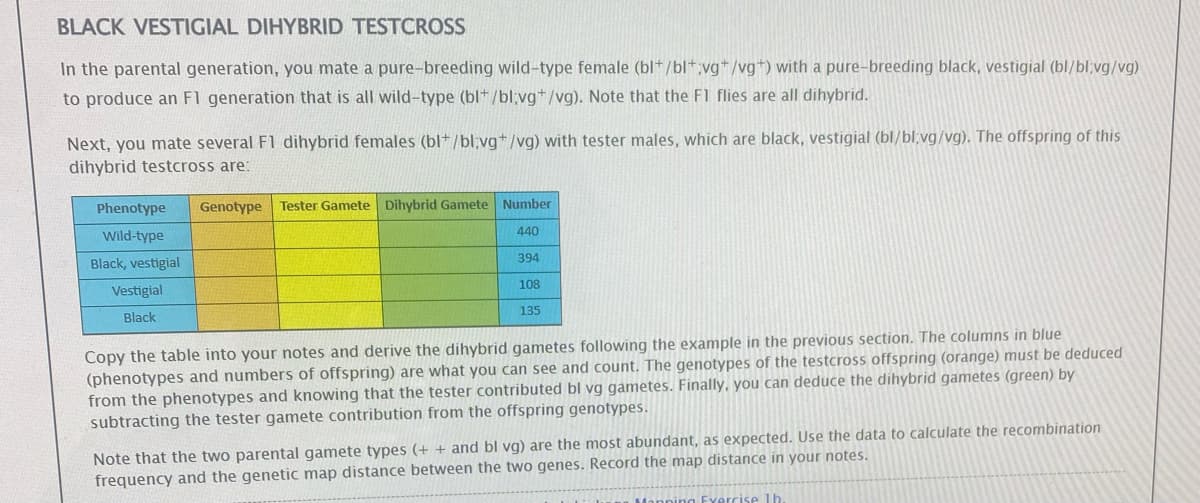BLACK VESTIGIAL DIHYBRID TESTCROSS In the parental generation, you mate a pure-breeding wild-type female (bl+/bl*:vg+/vg+) with a pure-breeding black, vestigial (bl/bl;vg/vg) to produce an F1 generation that is all wild-type (bl+/bl vg+/vg). Note that the F1 flies are all dihybrid. Next, you mate several F1 dihybrid females (bl+/bl vg+/vg) with tester males, which are black, vestigial (bl/bl vg/vg). The offspring of this dihybrid testcross are: Phenotype Genotype Tester Gamete Dihybrid Gamete Number 440 Wild-type 394 Black, vestigial 108 Vestigial 135 Black Copy the table into your notes and derive the dihybrid gametes following the example in the previous section. The columns in blue (phenotypes and numbers of offspring) are what you can see and count. The genotypes of the testcross offspring (orange) must be deduced from the phenotypes and knowing that the tester contributed bl vg gametes. Finally, you can deduce the dihybrid gametes (green) by subtracting the tester gamete contribution from the offspring genotypes. Note that the two parental gamete types (+ + and bl vg) are the most abundant, as expected. Use the data to calculate the recombination frequency and the genetic map distance between the two genes. Record the map distance in your notes.
BLACK VESTIGIAL DIHYBRID TESTCROSS In the parental generation, you mate a pure-breeding wild-type female (bl+/bl*:vg+/vg+) with a pure-breeding black, vestigial (bl/bl;vg/vg) to produce an F1 generation that is all wild-type (bl+/bl vg+/vg). Note that the F1 flies are all dihybrid. Next, you mate several F1 dihybrid females (bl+/bl vg+/vg) with tester males, which are black, vestigial (bl/bl vg/vg). The offspring of this dihybrid testcross are: Phenotype Genotype Tester Gamete Dihybrid Gamete Number 440 Wild-type 394 Black, vestigial 108 Vestigial 135 Black Copy the table into your notes and derive the dihybrid gametes following the example in the previous section. The columns in blue (phenotypes and numbers of offspring) are what you can see and count. The genotypes of the testcross offspring (orange) must be deduced from the phenotypes and knowing that the tester contributed bl vg gametes. Finally, you can deduce the dihybrid gametes (green) by subtracting the tester gamete contribution from the offspring genotypes. Note that the two parental gamete types (+ + and bl vg) are the most abundant, as expected. Use the data to calculate the recombination frequency and the genetic map distance between the two genes. Record the map distance in your notes.
Biology: The Dynamic Science (MindTap Course List)
4th Edition
ISBN:9781305389892
Author:Peter J. Russell, Paul E. Hertz, Beverly McMillan
Publisher:Peter J. Russell, Paul E. Hertz, Beverly McMillan
Chapter13: Genes, Chromosomes, And Human Genetics
Section: Chapter Questions
Problem 8TYK: Another gene in Drosophila determines wing length. The dominant wild-type allele of this gene...
Related questions
Topic Video
Question

Transcribed Image Text:BLACK VESTIGIAL DIHYBRID TESTCROSS
In the parental generation, you mate a pure-breeding wild-type female (bl+/blt.vg+/vg+) with a pure-breeding black, vestigial (bl/bl vg/vg)
to produce an F1 generation that is all wild-type (bl+/bl vg+/vg). Note that the F1 flies are all dihybrid.
Next, you mate several F1 dihybrid females (bl+/bl vg+/vg) with tester males, which are black, vestigial (bl/bl;vg/vg). The offspring of this
dihybrid testcross are:
Phenotype Genotype Tester Gamete Dihybrid Gamete Number
440
Wild-type
394
108
135
Black, vestigial
Vestigial
Black
Copy the table into your notes and derive the dihybrid gametes following the example in the previous section. The columns in blue
(phenotypes and numbers of offspring) are what you can see and count. The genotypes of the testcross offspring (orange) must be deduced
from the phenotypes and knowing that the tester contributed bl vg gametes. Finally, you can deduce the dihybrid gametes (green) by
subtracting the tester gamete contribution from the offspring genotypes.
Note that the two parental gamete types (+ + and bl vg) are the most abundant, as expected. Use the data to calculate the recombination
frequency and the genetic map distance between the two genes. Record the map distance in your notes.
Expert Solution
This question has been solved!
Explore an expertly crafted, step-by-step solution for a thorough understanding of key concepts.
Step by step
Solved in 3 steps with 1 images

Knowledge Booster
Learn more about
Need a deep-dive on the concept behind this application? Look no further. Learn more about this topic, biology and related others by exploring similar questions and additional content below.Recommended textbooks for you

Biology: The Dynamic Science (MindTap Course List)
Biology
ISBN:
9781305389892
Author:
Peter J. Russell, Paul E. Hertz, Beverly McMillan
Publisher:
Cengage Learning

Human Heredity: Principles and Issues (MindTap Co…
Biology
ISBN:
9781305251052
Author:
Michael Cummings
Publisher:
Cengage Learning


Biology: The Dynamic Science (MindTap Course List)
Biology
ISBN:
9781305389892
Author:
Peter J. Russell, Paul E. Hertz, Beverly McMillan
Publisher:
Cengage Learning

Human Heredity: Principles and Issues (MindTap Co…
Biology
ISBN:
9781305251052
Author:
Michael Cummings
Publisher:
Cengage Learning


Biology: The Unity and Diversity of Life (MindTap…
Biology
ISBN:
9781305073951
Author:
Cecie Starr, Ralph Taggart, Christine Evers, Lisa Starr
Publisher:
Cengage Learning

Biology (MindTap Course List)
Biology
ISBN:
9781337392938
Author:
Eldra Solomon, Charles Martin, Diana W. Martin, Linda R. Berg
Publisher:
Cengage Learning